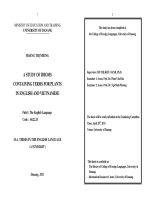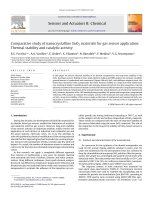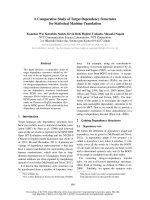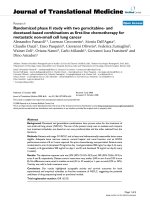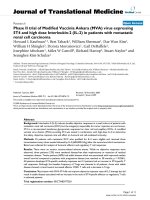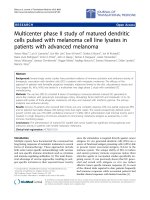Randomized phase II study of S-1 dosing schedule for resected colorectal cancer
Bạn đang xem bản rút gọn của tài liệu. Xem và tải ngay bản đầy đủ của tài liệu tại đây (400.13 KB, 4 trang )
Matsuda et al. BMC Cancer
DOI 10.1186/s12885-015-1476-6
STUDY PROTOCOL
Open Access
Randomized phase II study of S-1 dosing
schedule for resected colorectal cancer
Chu Matsuda1†, Mamoru Uemura2,7†, Ken Nakata3, Tatsushi Shingai4, Junichi Nishimura2, Taishi Hata2,
Masakazu Ikenaga5, Ichiro Takemasa2, Tsunekazu Mizushima2, Takeshi Kato6, Masataka Ikeda7, Masayuki Ohue8,
Kohei Murata9, Junichi Hasegawa5, Taroh Satoh10, Hirofumi Yamamoto2*, Mitsugu Sekimoto7, Riichiro Nezu11,
Yuichiro Doki2 and Masaki Mori2
Abstract
Background: Postoperative adjuvant chemotherapy for patients with stage III Colorectal cancer (CRC) is now
internationally accepted as standard care for improving patient outcomes. The Adjuvant Chemotherapy Trial of
S-1 for Colorectal Cancer (ACTS-CC) confirmed the non-inferiority of S-1 to tegafur/urcail/leucovorin in terms of
overall survival and disease-free survival in patients with stage III CRC after curative surgery. However, the 6-month
completion rate of S-1 treatment was 76.5 % in the ACTS-CC. Therefore, treatment completion remains an unresolved
problem.
Methods/Design: A randomized phase II trial was designed to evaluate the efficacy and safety of oral daily
administration and alternate-day administration of S-1 as adjuvant chemotherapy in curatively resected stage III CRC.
Enrolled patients were assigned to either S-1 daily administration (Arm A) or alternate-day S-1 administration (Arm B).
Assigned treatment will start within 8 weeks after surgery. In both arms, S-1 dosing (oral) will be based on body surface
area (80 mg/day for body surface area < 1.25 m2, 100 mg/day for 1.25–1.5 m2, or 60 mg/day for > 1.5 m2). In Arm A, S-1
will be administered orally for 28 days, followed by a 14-day rest. Administration will be conducted for 24 weeks from
the date of therapy start. In Arm B, S-1 will be administered orally on alternate days for 28 weeks from the date of the
start of therapy. After treatment, all patients will be observed without additional therapy unless recurrent lesions or
other cancer lesions occur. The primary endpoint is treatment completion rate. Secondary endpoints include 3-year
disease-free survival, compliance, and adverse events.
Discussion: Previously, S-1 alternate-day intake maintained the efficacy of chemotherapy while reducing adverse effects
for patients with R0-resected stage II/III gastric cancer. Improvement of chemotherapy completion rate for patients with
colorectal cancer will lead to an improved patient prognosis. Therefore, a randomized phase II trial has been designed
to examine the efficacy of alternate-day versus current standard daily S-1 administration as adjuvant chemotherapy for
R0-resected stage III colorectal cancer.
Trial registration: This study was registered on 18 February 2014 with University Hospital Medical Information Network
Clinical Trials Registry: UMIN000013185
Keywords: Colorectal cancer, Randomized phase II, S-1, Dose schedule
* Correspondence:
†
Equal contributors
2
Department of Surgery, Gastroenterological Surgery, Graduate School of
Medicine, Osaka University, 2-2 Yamada-oka, Suita City, Osaka 565-0871,
Japan
Full list of author information is available at the end of the article
© 2016 Matsuda et al. This is an Open Access article distributed under the terms of the Creative Commons Attribution License
( which permits unrestricted use, distribution, and reproduction in any medium,
provided the original work is properly credited. The Creative Commons Public Domain Dedication waiver (http://
creativecommons.org/publicdomain/zero/1.0/) applies to the data made available in this article, unless otherwise stated.
Matsuda et al. BMC Cancer
Background
Colorectal cancer (CRC) is the second most common
cancer in Japan, affecting over 100,000 individuals [1]. The
Japanese Society for Cancer of the Colon and Rectum
(JSCCR) reported recurrence rates of 3.7 % for stage I
disease, 13.3 % for stage II disease, and 30.8 % for stage III
[2]. Postoperative adjuvant chemotherapy for patients with
stage III CRC is now internationally accepted as standard
care for improving patient outcomes. The 2010 JSCCR
guidelines recommend four regimens as adjuvant therapy for stage III CRC: i.v. 5-fluorouracil/leucovorin,
oral tegafur-uracil/leucovorin, capecitabine, and FOLFOX (5-fluorouracil/leucovorin plus oxaliplatin) [2].
S-1 is an oral anticancer agent containing tegafur,
gimeracil, and oteracil potassium in a molar ratio of
1:0.4:1 [3]. The Adjuvant Chemotherapy Trial of S-1
for Colorectal Cancer (ACTS-CC) confirmed the noninferiority of S-1 to tegafur/urcail/leucovorin in terms
of overall survival and disease-free survival in patients
with stage III CRC after curative surgery [4]. However,
the 6-month completion rate of S-1 treatment was
76.5 % in the ACTS-CC [4]. Therefore, treatment completion remains an unresolved problem.
Previously, S-1 alternate-day intake maintained the
efficacy of chemotherapy while reducing adverse effects, and was tolerable for patients with R0-resected
stage II/III gastric cancer [5]. Therefore, we planned a
multicenter, cooperative, prospective, randomized phase II
study to compare daily and alternate-day S-1 administration as postoperative adjuvant therapy for CRC.
Methods/Design
Registration of the protocol
This study protocol was registered on the website of
the University Hospital Medical Information Network,
Japan (protocol ID: UMIN000013185) on 18 February
2014. Details are available at: />cgi-open-bin/ctr/ctr.cgi?function=brows&action=brows
&type=summary&recptno=R000015242&language=J
Page 2 of 4
Study support
This study is supported by a grant from The Supporting Center for Clinical Research and Education (Osaka,
Japan), a nonprofit foundation.
Endpoints
The primary study endpoint is treatment completion
rate. Secondary endpoints include 3-year disease-free
survival, overall survival, compliance, and adverse events
defined by the Common Terminology Criteria for Adverse Events v.4.0 [6].
Eligibility criteria
Patients who received curative resection for histopathologically demonstrated stage III (Japanese Classification
of Colorectal Cancer 8th edition [7]) colon or rectosigmoid
adenocarcinoma were eligible to participate in this study.
The main eligibility criteria were: age 20–80 years, starting
chemotherapy within 8 weeks after surgery, having an
Eastern Cooperative Oncology Group performance status
of 0–1, adequate oral intake, preserved major organ functions, and the ability to provide informed consent.
Patients were excluded if they had a previous history of
therapy for stage III CRC (except surgery), previous or
concomitant CRC (except carcinoma in situ), an active
malignancy within 5 years, a history of severe anaphylaxis
or allergies to any drug, significant active illness that
would preclude protocol treatment, undergoing treatment
with fluorocytosine, hepatitis B or C virus infection, or severe mental disease. Pregnant or lactating females were
also excluded.
Protocol treatment will begin when the patient fulfills
the following criteria: total leukocytes <12,000/mm3, neutrophils ≥ 1500/mm3, platelets ≥100,000/mm3, hemoglobin
≥ 9.0 g/dL, aspartate aminotransferase and alanine aminotransferase < 100 IU/L, total bilirubin < 2.0 mg/dL, and creatinine clearance ≥ 60 mL/min.
Registration
Digest of the study protocol
Objective
A randomized phase II trial was designed to evaluate
the efficacy and safety of oral daily administration and
alternate-day administration of S-1 as adjuvant chemotherapy in curatively resected stage III CRC. This study
protocol was approved by the Institutional Protocol
Review Board of Osaka General Medical Center (the affiliation of the Principal Investigator) and other participating
institutions (Additional file 1).
Study setting
This study is a multi-institutional, prospective, randomized controlled trial that will begin on 1 April, 2014.
After confirming eligibility, enrolled patients were randomly assigned to receive either standard daily S-1
therapy (Arm A) or alternate-day S-1 therapy (Arm B)
at the MCSGO Data Center. Randomization was performed via a minimization method with stratification
by lymph node status (N1 vs. N2 and N3), age (< 70 years
vs. ≥ 70 years), and institution (Fig. 1).
Treatment methods
Enrolled patients were assigned to either S-1 daily
administration (Arm A) or alternate-day S-1 administration (Arm B). Assigned treatment will start within
8 weeks after surgery. In both arms, S-1 dosing (oral)
will be based on body surface area (80 mg/day for body
Matsuda et al. BMC Cancer
Page 3 of 4
Fig. 1 Study design
surface area < 1.25 m2, 100 mg/day for 1.25–1.5 m2, or
60 mg/day for > 1.5 m2).
In Arm A, S-1 will be administered orally for 28 days,
followed by a 14-day rest. Administration will be conducted for 24 weeks from the date of therapy start. In
Arm B, S-1 will be administered orally on alternate
days for 28 weeks from the date of the start of therapy
(Fig. 1). After treatment, all patients will be observed
without additional therapy unless recurrent lesions or
other cancer lesions occur.
In each course, treatment will continue when the
patients fulfill the following criteria: total leukocytes
≥ 3000/mm3, platelets ≥ 100,000/mm3, aspartate aminotransferase and alanine aminotransferase < 100 IU/L,
total bilirubin < 2.0 mg/dL, creatinine ≤ 1.5 mg/dL, and
diarrhea and stomatitis no greater than grade 1. If the
criteria for continuing treatment are not met, then
treatment will be postponed or temporarily suspended
until the criteria are satisfied.
Study design and statistical methods
The primary endpoint of this study is treatment completion rate, which is expected to be higher than the treatment completion rate in the ACTS-CC [4] due to
alternate-day S-1 administration. Assuming a null
hypothesis of 73 % treatment completion and an alternative hypothesis of 83 % treatment completion with
one-sided type I error = 0.1 and type II error = 0.2, it
was necessary to enroll at least 77 patients in each arm.
Assuming 10 % loss to follow-up, we calculated that a
total of 170 patients were needed in both treatment arms.
Decision principle
At the beginning of the study, we established the decision principle to be used after trial results are obtained.
If the treatment completion rate for alternate-day S-1
administration (Arm B) is better than that for daily S-1
administration (Arm A), and if the 3-year disease-free
survival and adverse-events rates of Arm B is improved
or approximately the same as those of Arm A, then
alternate-day S-1 administration will be recommended
as adjuvant chemotherapy for stage III R0-resected CRC
patients.
Discussion
The feasibility of S-1 treatment as an adjuvant chemotherapy for colorectal cancer was confirmed by ACTSCC [4], although the protocol treatment completion rate
remained 76.5 %. Previously, S-1 alternate-day intake
maintained the efficacy of chemotherapy while reducing
adverse effects for patients with R0-resected stage II/III
gastric cancer [5]. Improvement of chemotherapy completion rate for patients with colorectal cancer will lead
to an improved patient prognosis.
Therefore, a randomized phase II trial has been designed
to examine the efficacy of alternate-day versus current
standard daily S-1 administration as adjuvant chemotherapy for R0-resected stage III colorectal cancer.
Additional file
Additional file 1: All Ethics Committees that approved the study.
(16KB)
Matsuda et al. BMC Cancer
Page 4 of 4
Competing interests
The authors declare that they have no competing interests.
Authors’ contributions
All authors (CM, MU, KN, TS, JN, TH, MI (Masakazu Ikenaga), IT, TM, TK, MI
(Masataka Ikeda), MO, KM, JH, TS, HY, MS, RN, YD, MM) contributed to the
protocol design and reviewed and edited the manuscript. All authors will be
responsible for the acquisition of study data. CM, HY, MS, NR, DY, and MM
planned, coordinated and conducted the study. CM and MU mainly drafted
the manuscript, and all authors were involved in drafting the manuscript.
All authors read and approved the final manuscript.
Acknowledgement
This study will be carried out on behalf of the Clinical Study Group of
Osaka University (CSGO), Colorectal Group. Study number was assigned as
CSGO-CR1401. This study is supported by a grant from The Supporting
Center for Clinical Research and Education (SCCRE; Osaka, Japan), a nonprofit
foundation. This protocol was reviewed and accepted by the SCCRE.
Author details
1
Department of Surgery, Osaka General Medical Center, Osaka, Japan.
2
Department of Surgery, Gastroenterological Surgery, Graduate School of
Medicine, Osaka University, 2-2 Yamada-oka, Suita City, Osaka 565-0871,
Japan. 3Department of Surgery, Sakai City Hospital, Osaka, Japan.
4
Department of Surgery, Osaka Saiseikai Senri Hospital, Osaka, Japan.
5
Department of Surgery, Osaka Rosai Hospital, Osaka, Japan. 6Department of
Surgery, Kansai Rosai Hospital, Hyogo, Japan. 7Department of Surgery,
National Hospital Organization, Osaka National Hospital, Osaka, Japan.
8
Department of Surgery, Osaka Medical Center for Cancer and Cardiovascular
Diseases, Osaka, Japan. 9Department of Surgery, Suita Municipal Hospital,
Osaka, Japan. 10Department of Frontier Science for Cancer and Chemotherapy,
Graduate School of Medicine, Osaka University, Osaka, Japan. 11Department of
Surgery, Nishinomiya Municipal Central Hospital, Hyogo, Japan.
Received: 21 August 2014 Accepted: 27 May 2015
References
1. Cancer statistics in Japan 2012. Available at: />professional/statistics/backnumber/2012/cancer_statistics_2012.pdf, 2013.
2. Watanabe T, Itabashi M, Shimada Y, et al. Japanese Society for Cancer of the
Colon and Rectum (JSCCR) guidelines 2010 for the treatment of colorectal
cancer. Int J Clin Oncol. 2012;17:1–29.
3. Shirasaka T, Shimamato Y, Ohshimo H, et al. Development of a novel form
of an oral 5-fluorouracil derivative (S-1) directed to the potentiation of the
tumor selective cytotoxicity of 5-fluorouracil by two biochemical modulators.
Anticancer Drugs. 1996;7:548–57.
4. Nakamoto Y, Ishiguro IM, Yoshida M, et al. Noninferiority of S-1 to UFT/LV as
adjuvant chemotherapy for stage III colon cancer: A randomized phase III
trial (ACTS-CC). J Clin Oncol. 2013;(suppl; abstr 3518).
5. Tatebe S, Tsujitani S, Nakamura S, et al. Feasibility study of alternate-day S-1
as adjuvant chemotherapy for gastric cancer: a randomized controlled trial.
Gastric Cancer, 2013. [Epub ahead of print].
6. Common Terminology Criteria for Adverse Events (CTCAE) v4.0. (http://
ctep.cancer.gov/protocolDevelopment/electronic_applications/
ctc.htm#ctc_40). 2011.
7. Japanese Society for Cancer of the Colon and Rectum, Japanese Society for
Cancer of the Colon and Rectum. Japanese classification of colorectal
carcinoma. 8th ed. Kanehara: Japanese Society for Cancer of the Colon
and Rectum; 2009.
Submit your next manuscript to BioMed Central
and take full advantage of:
• Convenient online submission
• Thorough peer review
• No space constraints or color figure charges
• Immediate publication on acceptance
• Inclusion in PubMed, CAS, Scopus and Google Scholar
• Research which is freely available for redistribution
Submit your manuscript at
www.biomedcentral.com/submit
